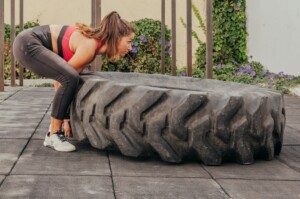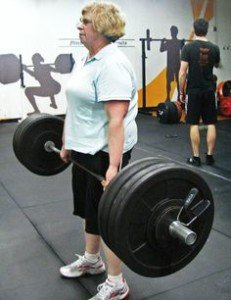
“Ma’am, I know this’s none of my business but that tire is too heavy for you; you shouldn’t be lifting it.”
Is 1RM dangerous for a woman? Should she give up?
Some men (and women) are still stuck in the Dark Ages when it comes to women’s strength training.
I’ve been a member of 24-Hour Fitness. There’s only one in the large city I now reside in, and it’s permanently closing down soon.
The next nearest 24 is an hour away, so I joined Crunch Fitness.
At the 24 was a stationary tire apparatus that I’d lift only part way for multiple-rep tire squats.
This exercise is invaluable for strengthening not only the legs but the lower and middle back.
The Crunch Fitness gym doesn’t have this equipment; instead it has a real tire: a giant one.
Hoisting it up doesn’t involve the same biomechanics involved with the stationary tire. It’s also a ton heavier, even though I’d have the 24 tire loaded with weights.
It’s so heavy that, at the time of this publication, I can do only one repetition. I rest, then do another single rep. This tire is a 1RM for me.
At the top or apex of the movement, my legs are straight, and my arms are straight with my hands below me as I’m leaning forward into the tire.
Furthermore, I’m not (yet) strong enough to lower it with control; I let it fall back down. This is a BIG tire.
My goal is to eventually be doing five consecutive reps with controlled negatives.
My Second Time with This Tire
The row of treadmills is right by the area where the tire is.
My plan was to do five 1RM’s, with of course, about a one-minute rest in between each one.
The first rep didn’t go too well; I barely lifted it off the floor.
The second rep was better; my legs were nearly straight, and then I let the tire plop back down, springing my body out of the way.
Then I heard, off from the side, “Ma’am? Ma’am?”
I turned towards the treadmills. One was in use, by an old man, I’d say in his 70s, possibly early 80s.
I walked over to him, having a feeling that he wasn’t going to say something I wanted to hear.
He said, “Ma’am, I know this is none of my business, but that tire is too heavy for you; you shouldn’t be lifting it.”
This took me by surprise. I responded, “Would you be telling me this if I were a man?”
He replied, “Yes I would if he was as small as you. That’s too hard for you.”
I said, “It’s supposed to be hard. In a few weeks it’ll be my warmup.”
“You’ll get a hernia,” he said.
I then delivered the bomb: “I’m not gonna take advice from someone who holds onto a treadmill.”
He laughed and said, “You go do your own thing!”
I returned to the tire. The next three reps, with their in-between minute rests, went very well, with my legs extending nicely, and each time I had to let the tire loudly plop back down.
Not once had I looked back at the man, but I knew he’d been watching me.
There are so many things wrong with his observation, so let’s peel it apart.
“It’s Too Heavy for You; You Shouldn’t Be Lifting It.”
I could’ve given this man a dissertation on the value of the 1RM for strength training.
I could’ve informed him that powerlifting competitions, in which many women compete, are based on the one rep max.
How do competitors train for the 1RM? By doing a 1RM. There are exceptions, but most competitive powerlifters, including women, work on their 1RM’s for the deadlift, back squat and bench press.
It’s no more dangerous to them than it is for a man twice their size.
A 1RM is a 1RM is a 1RM, whether you’re a short slender woman or a tall hulking man.
Proper form is critical, which this man knows nothing about, being that he was somewhat slumped forward while holding onto the side rails of the treadmill (this make-believe walking skewers posture, eliminates core involvement, teaches un-balancing and essentially trains the body to use a walker — which are the last things that an aging body needs!).
The key to proper form when lifting something heavy off the ground (I’ve been deadlifting for years) is to maintain an arch in the lower back, and never let the hips get above the shoulders; and lift with the legs.
If I can’t maintain this proper form, I’m not going to attempt to complete even a 1RM tire lift.
The Man Thought I Was too Small
I’m 5’8 with an athletic or “trained” looking physique.
However, it must be pointed out that a small person can be quite strong.
Short stature does not impede muscle growth or strength gains.
The Man Did Not Know My History
I’ve been lifting weights since high school. Based on the man’s physique, whatever weight training he’d been doing was marginal.
Now, I know he was old, but I’ve seen other “old” men at the gym who had impressive physiques.
This particular man looked like the average elderly man.
This told me that he had never been into intense, heavy strength training, and thus, had no concept of the value of the 1RM.
Being Able to Do Only One Rep

If a woman (or man) can do only a single rep with a particular movement, due to very heavy resistance, just how is she supposed to get stronger with that movement if she quits because someone told her she shouldn’t do it?
Ever see a woman doing pullups for reps? She didn’t start out doing multiple consecutive reps. She started out with just one rep: a 1RM.
Then she built up on this, eventually hitting two reps, and over time, worked her way up to eight or 10 or 12.
A tire lift is a very unique movement; it’ll require more tire lifts to get stronger with this compound movement.
Again, PROPER FORM is so important. This includes correct breathing!
With correct form, proper breathing and knowing when to par back or take breaks, you will not have to worry about getting a hernia.
Taking advice from someone who holds onto a treadmill?

Depositphotos.com
No thank you. Though I’ve seen accomplished bodybuilders and other muscle building enthusiasts holding onto a treadmill, the fact that this man — who appeared in poor physical condition — was holding onto the treadmill, told me that his knowledge of proper walking form was non-existent.
And I’ve seen other men visibly his age not holding on. This issue is almost never related to disability (I’ve done heavy research on this including in person; trust me).
It may seem wise for an old person to hold on, but when I was a personal trainer, I had every single one of my older (and younger) clients walking hands-free, which means NATURALLY, upright, with good posture and core engagement.
This man did not have a cane. He walked without any problem amid the weight machines.
His mindset is old-school, that it’s dangerous for women (unless maybe they’re 6’2) to perform one rep maxes, especially with a manly-looking object like a giant truck tire.
I told him that “in a few weeks it’ll be my warmup.” Well, I exaggerated there.
But the message is that eventually (and hopefully not too far into the future), I’ll be performing five consecutive repetitions with controlled lowering.
If you’re a woman who’s struggling with a 1RM, just make sure your form is spot-on, and that you’re not trying to “work through” any joint pain or injuries.
A 1RM is no more unsafe as a workout for a woman than it is for a man.
But this is not to be confused with any individual having a medical condition for which 1RM’s are potentially unsafe.
 Lorra Garrick is a former personal trainer certified through the American Council on Exercise. At Bally Total Fitness she trained women and men of all ages for fat loss, increased strength, muscle building, fitness and improved cardiovascular and overall health.
Lorra Garrick is a former personal trainer certified through the American Council on Exercise. At Bally Total Fitness she trained women and men of all ages for fat loss, increased strength, muscle building, fitness and improved cardiovascular and overall health.
.


























